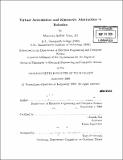| dc.contributor.advisor | Daniela Rus. | en_US |
| dc.contributor.author | Vona, Marsette Arthur, 1977- | en_US |
| dc.contributor.other | Massachusetts Institute of Technology. Dept. of Electrical Engineering and Computer Science. | en_US |
| dc.date.accessioned | 2010-04-28T17:14:22Z | |
| dc.date.available | 2010-04-28T17:14:22Z | |
| dc.date.copyright | 2009 | en_US |
| dc.date.issued | 2009 | en_US |
| dc.identifier.uri | http://hdl.handle.net/1721.1/54646 | |
| dc.description | Thesis (Ph. D.)--Massachusetts Institute of Technology, Dept. of Electrical Engineering and Computer Science, 2009. | en_US |
| dc.description | Cataloged from PDF version of thesis. | en_US |
| dc.description | Includes bibliographical references (p. 279-292). | en_US |
| dc.description.abstract | This thesis presents the theory, implementation, novel applications, and experimental validation of a general-purpose framework for applying virtual modifications to an articulated robot, or virtual articulations. These can homogenize various aspects of a robot and its task environment into a single unified model which is both qualitatively high-level and quantitatively functional. This is the first framework designed specifically for the mixed real/virtual case. It supports arbitrary topology spatial kinematics, a broad catalog of joints, on-line structure changes, interactive kinostatic simulation, and novel kinematic abstractions, where complex subsystems are simplified with virtual replacements in both space and time. Decomposition algorithms, including a novel method of hierarchical subdivision, enable scaling to large closed-chain mechanisms with 100s of joints. Novel applications are presented in two areas of current interest: operating high- DoF kinematic manipulation and inspection tasks, and analyzing reliable kinostatic locomotion strategies based on compliance and proprioception. In both areas virtual articulations homogeneously model the robot and its task environment, and abstractions structure complex models. For high-DoF operations the operator attaches virtual joints as a novel interface metaphor to define task motion and to constrain coordinated motion (by virtually closing kinematic chains); virtual links can represent task frames or serve as intermediate connections for virtual joints. For compliant locomotion, virtual articulations model relevant compliances and uncertainties, and temporal abstractions model contact state evolution. | en_US |
| dc.description.abstract | (cont.) Results are presented for experiments with two separate robotic systems in each area. For high-DoF operations, NASA/JPL's 36 DoF ATHLETE performs previously challenging coordinated manipulation/inspection moves, and a novel large-scale (100s of joints) simulated modular robot is conveniently operated using spatial abstractions. For compliant locomotion, two experiments are analyzed that each achieve high reliability in uncertain tasks using only compliance and proprioception: a novel vertical structure climbing robot that is 99.8% reliable in over 1000 motions, and a mini-humanoid that steps up an uncertain height with 90% reliability in 80 trials. In both cases virtual articulation models capture the essence of compliant/proprioceptive strategies at a higher level than basic physics, and enable quantitative analyses of the limits of tolerable uncertainty that compare well to experiment. | en_US |
| dc.description.statementofresponsibility | by Marsette Arthur Vona, III. | en_US |
| dc.format.extent | 292 p. | en_US |
| dc.language.iso | eng | en_US |
| dc.publisher | Massachusetts Institute of Technology | en_US |
| dc.rights | M.I.T. theses are protected by
copyright. They may be viewed from this source for any purpose, but
reproduction or distribution in any format is prohibited without written
permission. See provided URL for inquiries about permission. | en_US |
| dc.rights.uri | http://dspace.mit.edu/handle/1721.1/7582 | en_US |
| dc.subject | Electrical Engineering and Computer Science. | en_US |
| dc.title | Virtual articulation and kinematic abstraction in robotics | en_US |
| dc.type | Thesis | en_US |
| dc.description.degree | Ph.D. | en_US |
| dc.contributor.department | Massachusetts Institute of Technology. Department of Electrical Engineering and Computer Science | |
| dc.identifier.oclc | 606590010 | en_US |
